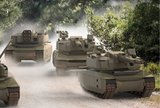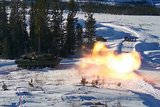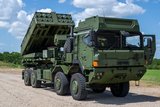Lockheed Martin demonstrates new ambush-thwarting push-vehicle capability for automated convoy program
Lockheed Martin has developed a new push-vehicle capability for its automated convoy program that will save lives in the fight against convoy ambush and IED attacks. The Convoy Active Safety Technology system, which enables convoy vehicles to autonomously follow each other, demonstrated the push-vehicle feature recently. It allows the first vehicle to be driven autonomously, as compared to past system designs where the lead had to be under human control.
"CAST's push-vehicle capability directly responds to real life dangers that our troops are facing. It will prevent injury and loss of life in the forward vehicle, which most frequently bears the brunt of deadly ambushes and IED attacks," said Glenn Miller, vice president of Technical Operations and Applied Research at Lockheed Martin Missiles and Fire Control. "CAST already improves the safety, security, survivability and sustainment of tactical wheeled vehicles. Our proven push-vehicle feature takes that to another level."
The autonomous push-vehicle was developed to lead a convoy of semi-autonomous follower vehicles into hazardous areas without a human operator on board. Using the AutoMate sensor, actuator and processing kit, any tactical wheeled vehicle can quickly and easily convert into the push-vehicle or perform as part of the convoy. Even in this role, the vehicle can maintain safe trajectories and interval distances on both developed and undeveloped roadways, avoid dynamic obstacles and operate at full speed in visually obstructed conditions such as dust or blackout night operations.
Lockheed Martin tested CAST's new capability this month in internal tests and is ready to demonstrate its life-saving features to Warfighters during user assessments. Notably, CAST demonstrated its precision system during the Army's Robotics Rodeo held last year at Fort Hood, TX.
CAST is a development program for the US Army Tank Automotive Research, Development and Engineering Center. The affordable, simple, kit-based technology is not dependent on any platform and has logged more than 10,000 miles of operation. Tests have proved CAST-enabled trucks can follow roads and other vehicles to eliminate rear-end collisions, reduce road departures and enable soldiers to respond to 25 percent more hostile threats and from greater distances.
Source: Lockheed Martin
More from Land Warfare
-
![Hungary set to begin using Hero 400 loitering munitions]()
Hungary set to begin using Hero 400 loitering munitions
Developed by Israel's Uvision and with systems being sold in the thousands to multiple European NATO countries and the US, the Hero family of loitering systems is also in production in the US and Italy, the latter through Rheinmetall.
-
![Light Reconnaissance Strike – enabling a vital mission set (Studio)]()
Light Reconnaissance Strike – enabling a vital mission set (Studio)
A new system-of-systems concept will unlock digital integration of sensors and weapons for Light Forces, allowing them to shape the battlefield environment on their own terms and upgrade legacy platforms.
-
![Lockheed Martin to look further afield for GMARS rocket system opportunities]()
Lockheed Martin to look further afield for GMARS rocket system opportunities
The HX truck is already in use in many NATO and allied countries around the world as a logistics vehicle and carrier for high-value systems, including missile firing weapons, so its use for the Global Mobile Artillery Rocket System makes logistical sense.






















